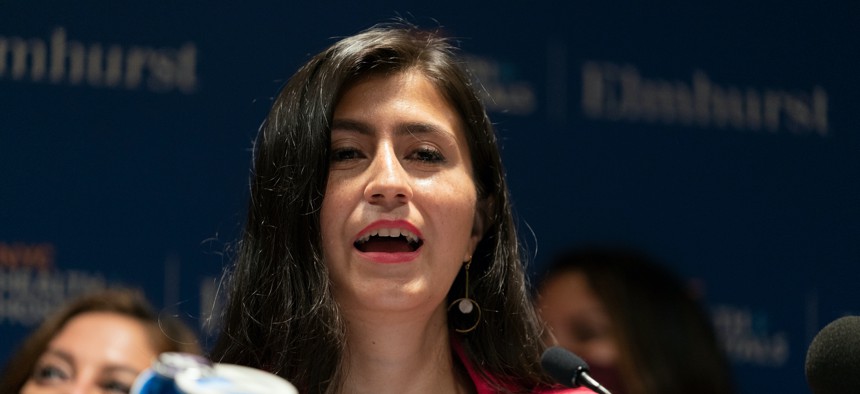Labor
15 state lawmakers request more money for Excluded Workers Fund
The pandemic aid for undocumented workers has run out faster than expected.

State Sen. Jessica Ramos and 14 other state lawmakers called on Gov. Kathy Hochul to "support in supplementing the Excluded Workers Fund with additional resources." lev radin/Shutterstock
Just over two months since the Excluded Workers Fund – $2.1 billion set aside for undocumented immigrants who were unemployed during the pandemic and did not receive unemployment benefits – opened, the state Department of Labor decided that no new applicants would be accepted after Oct. 8. The fund was nearing exhaustion, and the state couldn’t guarantee that people who had already submitted an application would receive money. When the window closed, over 350,000 people had applied. As of Tuesday afternoon, the labor department had approved over 125,000 applications and allocated over $1.2 billion, leaving less than half of the money in the fund for the remaining 225,000 applicants.
“That’s why we sent a letter to Gov. (Kathy) Hochul,” said state Sen. Jessica Ramos, the original sponsor of the legislation to create the Excluded Workers Fund before it was included in the budget last year. “We need her to add money to the fund as much as is possible right now.” In a letter shared exclusively with City & State, Ramos and 14 other state lawmakers asked the governor to direct Labor Department Commissioner Roberta Reardon to ease some of the application requirements, and called on the governor for “support in supplementing the Excluded Workers Fund with additional resources.” The letter does not ask for a specific amount, but earlier this year, advocates had asked for $3.5 billion, which was already a compromise from the $5 billion they had originally sought. “What I would like to see is anybody who lost work be able to seek the relief that they need. That’s what I want,” Ramos said.
A spokesperson for Hochul did not directly answer a question about whether the governor would support more money for the Excluded Workers Fund and if she would do so before next year’s budget. Instead, the spokesperson directed City & State to a press release from Friday about the program’s success in allocating $1.2 billion that made no mention of expanding the fund.
Immigrant and worker advocates commended the Hochul administration for getting money out to those in need, but the rollout of the landmark program has had some bumps.
“I think the fact that it’s gone so quickly, and really I think gone so well, is evidence that it was really needed and that the initial estimate of how much was needed was too low,” said David Dyssegaard Kallick, director of the immigration research initiative at the left-leaning Fiscal Policy Institute. Earlier this year, Kallick released a report that estimated about 290,000 New Yorkers would benefit from the fund. Of the fund’s two tiers, he estimated that the $15,600 that required more documentation would go to about 92,000 people, and the $3,200 with less formal documentation was expected to go to 199,000 people. According to the state labor department, 99.74% of applicants who had claims approved received $15,600.
No one who fought for the fund complained that applicants have since received the greater sum, but it did lead to the fund’s depletion faster than they expected. Bianca Guerrero, campaign coordinator of the Fund Excluded Workers Coalition, commended the labor department and the Hochul administration for getting the money out quickly and effectively, but said the state must make more money available to ensure people aren’t left out. “It shouldn’t be a matter of just like when you learned about the fund or where you live,” Guerrero said. Those who managed to get their applications together faster than others are more likely to receive money, even if others who applied later are equally qualified.
Specifically, money from the fund has not been equitably getting to every corner of the state. A recent analysis by the Fiscal Policy Institute found that a disproportionate share of money has so far gone to New York City. While the city has the lion’s share of the state’s undocumented population, other parts of the state have gotten less than they should proportionally. For example, the Hudson Valley has 3% of the state’s undocumented population but has gotten only 1% of the money, while New York City has 73% of the workers and has received 81% of the allocated funds.
“The rollout was a bit challenging, in many ways,” said Emma Kreyche, advocacy director at Workers Justice Center of New York, which focuses mainly on rural parts of the state. The organization had to overcome additional hurdles due to the increased distance required to contact those affected communities, something organizations in New York City didn’t face. She said that by the time her organization, which received funding from the state to educate people about the fund, had staffed up, it was already the end of August. Applications opened on the first of that month. “By then, nearly half of the funds had already been approved for disbursement, which put us really under a tremendous amount of pressure to reach out to our own communities,” Kreyche said. Without additional funding, people in rural parts of the state might lose out on aid despite doing everything right, just not fast enough.

